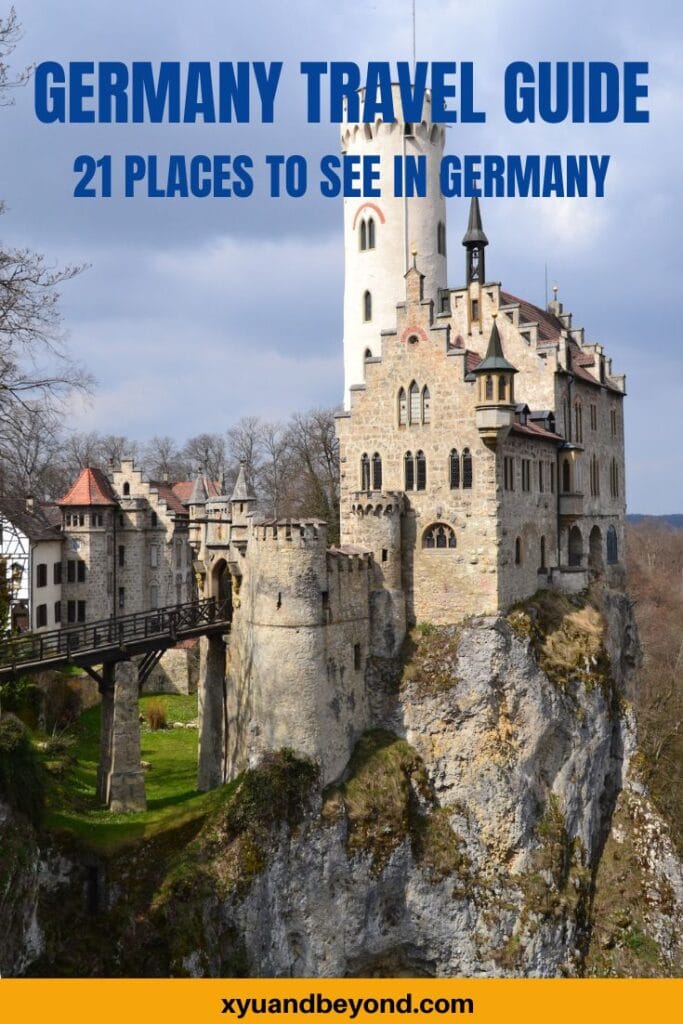Germany travel guide – 21 places to visit in Germany
Just imagine it over 2 millennia of history which means Germany is far more interesting to visit than Oktoberfest would have you think. Visiting Germany will treat you to a fascinating and rich history complete with fairytale castles, cathedrals soaring to the sky, and landscapes of forests, mountains and rivers.
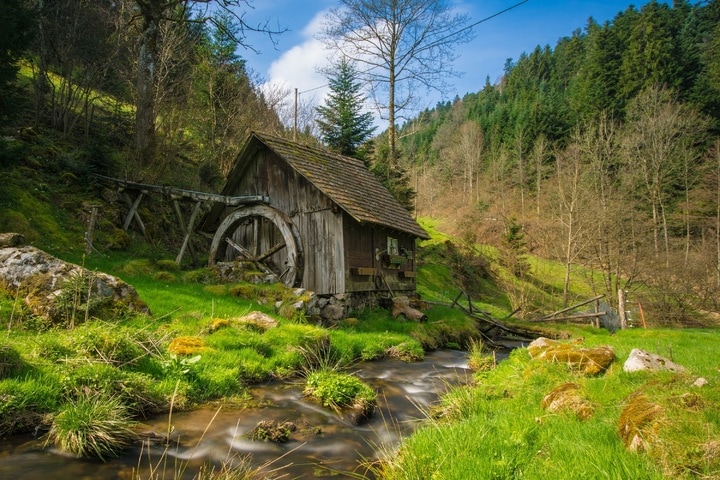
Germany is one of the top destinations in the world for travellers, and it is considered a Western European country its capital is Berlin which is home to the Brandenburg Gate, intense WWII sites and incredible nightlife and art scenes. Munich is of course known for its beer halls and Octoberfest, then there is Nuremberg steeped in history. These are just some of the cities you may know about but Germany has a vast and varied landscape and these cities are just the tip of the iceberg. There’s also romantic tours of the Rhine and the Danube there’s wine tasting tours, castles and historic tours so many things to do and see you will want to come back again and again.
Depending on where you are visiting in Germany you will have very different experiences from region to region.
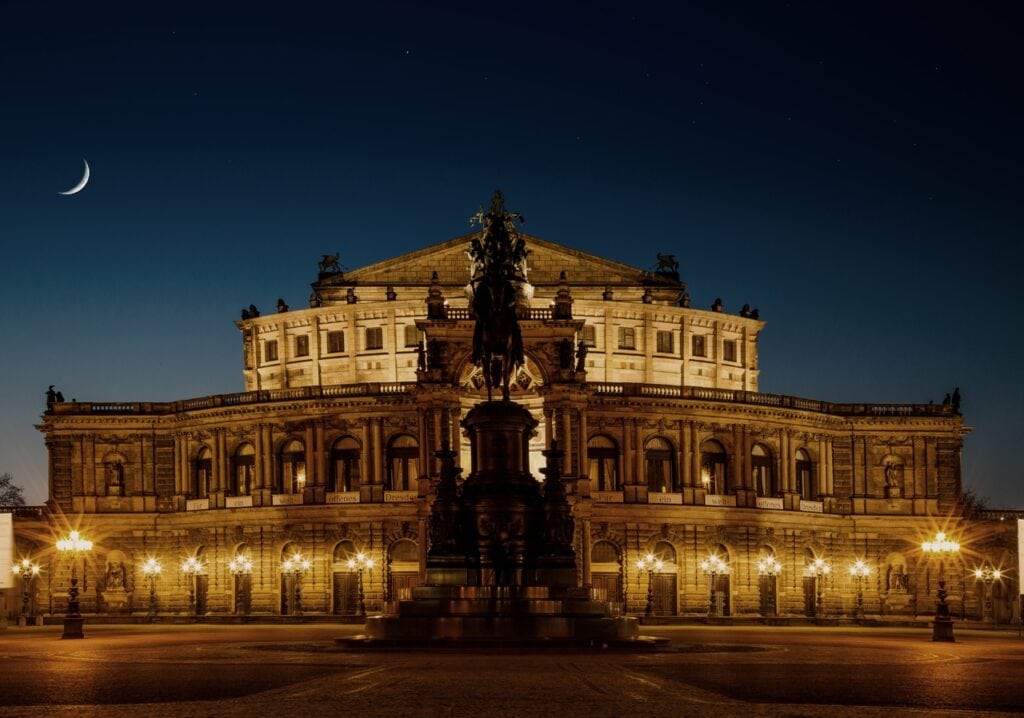
Where is Germany?
Germany is located in central Europe and shares borders with a lot of nearby countries, including Denmark, the Netherlands, Poland and the Czech Republic. You can see where Germany is located on the map below.
What is the capital of Germany?
The capital of Germany is Berlin, which is located in the northeast part of the country.
How big is Germany?
Germany has an area of 357,386 km², making it the 7th biggest country in Europe.
What is the currency in Germany?
Germany’s currency is the Euro, which they have used since 2002.
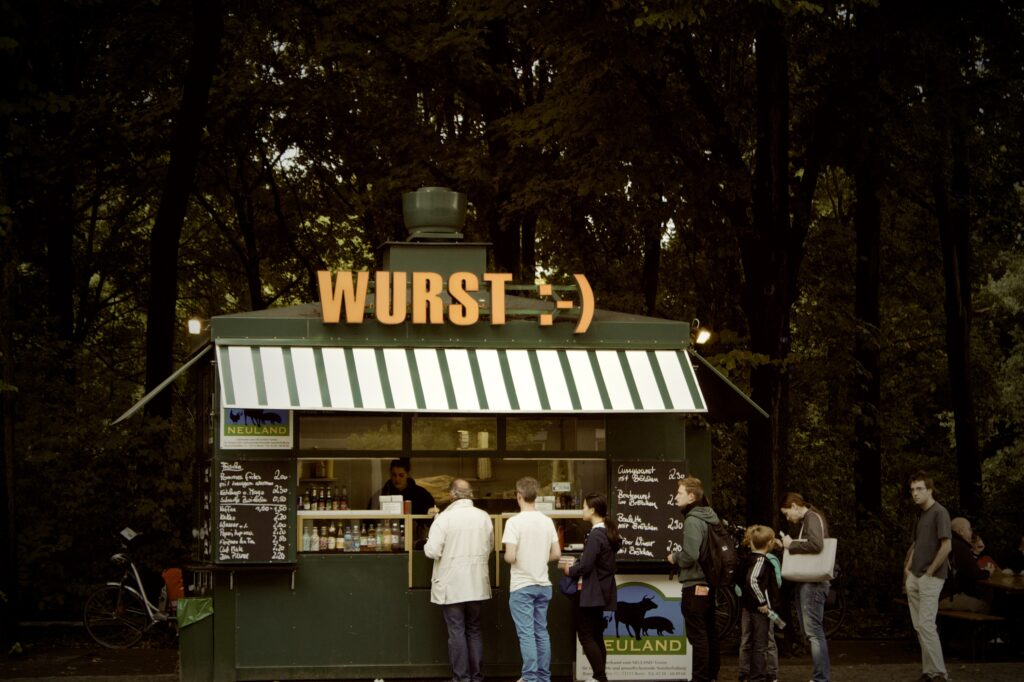
German food and drink
- In Germany, there are 1,500 different types of beer, 300 types of bread and 1,000 types of sausage
- Germany is home to the biggest Beer Festival in the world, Oktoberfest in Munich, where the standard glass of beer is a whole litre.
- If you want to order 1 beer in Germany, you show your thumb and for 2 beers you show your first finger.
More than 800 million currywurst sausages are eaten every year in Germany. The snack is so popular that there’s even a museum dedicated to it in Berlin.

- Germany is the second largest beer consumer in Europe – Germans drink around 2.55 billion gallons of it a year.
- You can find over 2100 castles throughout the country.
- The capital city, Berlin is 9 times bigger than Paris and has more bridges than Venice.
- 65% of the highways in Germany have no speed limit and are called the Autobahn
- Germany sells around 6 million cars a year, making it one of the largest car producers in the world.
- The first book ever printed was in German, and the first magazine was launched in Germany in 1663.
- Germany has more zoos than any other country, we have over 400.
- Germany is a very cultured country, with 6,200 museums, 820 theatres, 130 professional orchestras, and 8,800 libraries.
- When visiting Berlin, JFK famously said “Ich bin ein Berliner” which actually means “I am a jelly doughnut.”
- The Christmas tree trend was started in Germany and picked up by Queen Victoria in England.
- There are over 2,500 Christmas markets in Germany alone. The largest Christmas market in the world is located in Dresden, with over 250 stalls. The Dresden market is also one of the oldest, dating back to 1434
34 Tantalizing German foods – what to eat in Germany
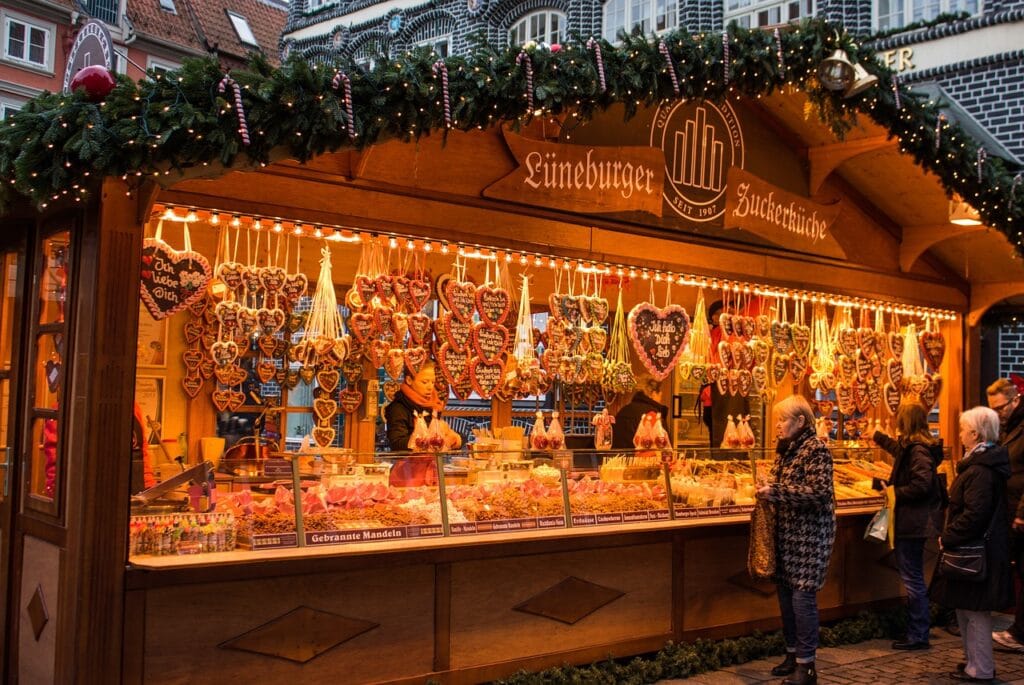
Germany travel guide
Berlin
It feels obligatory to visit Berlin just because it’s the capital of Germany, but this fascinating city is also much more than that. There are so many things to do in Berlin which is bursting with rich history, creative street art, breathtaking architecture, scrumptious culinary scene, and epic nightlife, there really is a lot for one to discover.
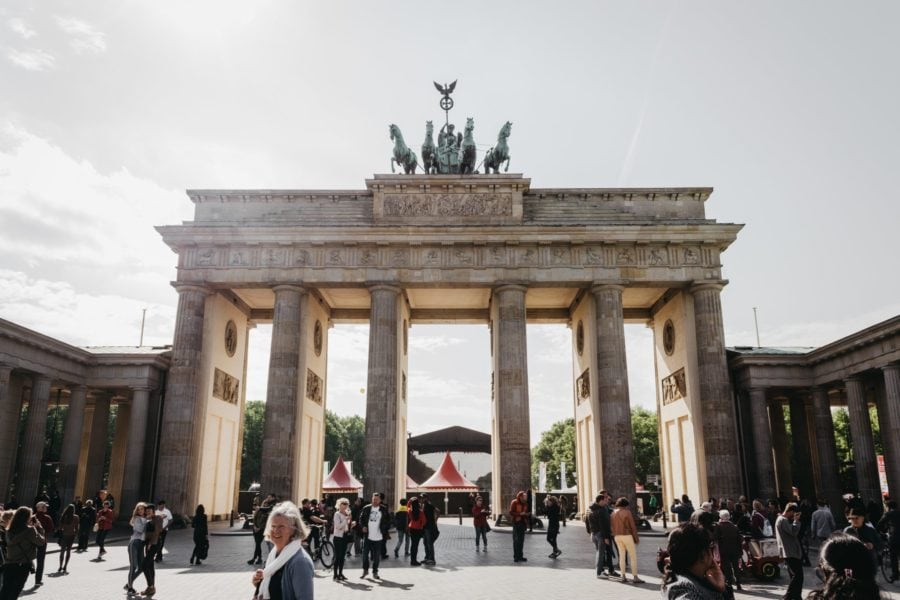
History aficionados would thrive here. Museum Island alone has five museums, with lots of great gems scattered around the city, like the Wall Memorial Museum. The nation’s past as a Soviet State may be harrowing, but it can be important to learn about this deep history. From the Jewish Museum, The Holocaust Memorial to the Topography of Terror, these are just some places to stop by.
The local food is also reason enough to visit Berlin. Their most famous dish, currywurst, is served in street stalls and restaurants alike, and you can find delicious doner kebabs throughout the city. In December, the numerous Christmas markets are a brilliant place for a food-tasting experience like no other.
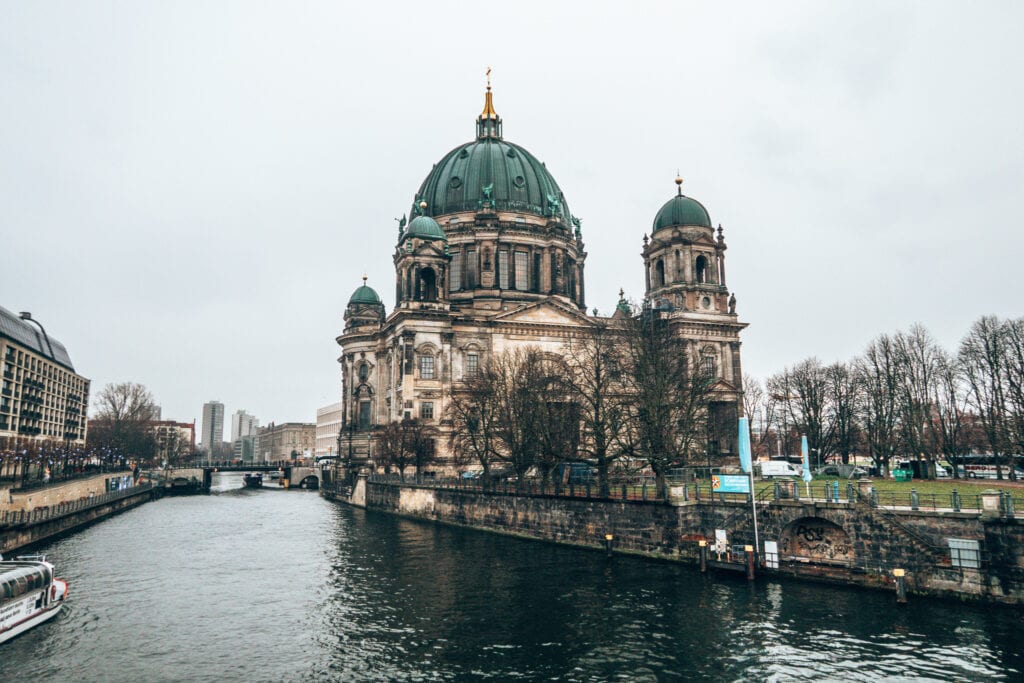
And of course, not to mention their reputation for producing world-class beer. While all of Germany are known to make excellent beers, Berliners are at the forefront of this craft. Their city is known as the beer capital of the world for a reason. From beer gardens and pubs to unique craft beer spots, you could spend days just exploring the beer landscape here.
The best thing about Berlin is that while it offers you a quick overview of the country’s culture, history, and cuisine, it’s also a perfect gateway to different remarkable destinations. Renting a campervan lets you explore places like the important Sachsenhausen Concentration Camp or peaceful Spreewald, just a few hour’s drive away! Contributed by Bradley of Dream Big Travel Far.
Konigssee Lake
The Königssee lake is located in Bavaria, Southern Germany, near the town Berchtesgaden. It’s a large elongated lake in the German alps, bordering Austria. König means king and See means lake in German.
The area was turned into a nature reserve and the lake is known as Germany’s most beautiful lake. A journey to the lake takes one first to the village of Schönau. A boat ride across the lake with a guide and short trumpet performance takes visitors to two different dockings.
The first station, and most popular of the two, is the pilgrimage site of St.Bartholomä. Visitors can explore the surrounding area, go for a swim in the crystal clear, but cold water, or enjoy some time in a beer garden with a cool beer, white sausages and Bretzel.
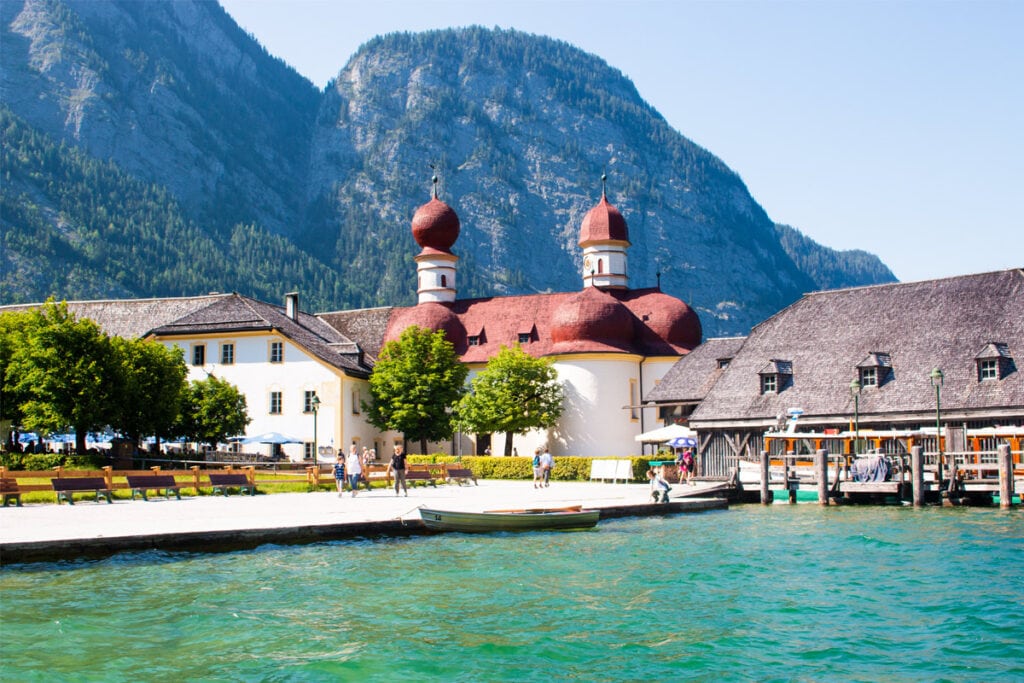
The second is the Salet stop, which is the starting point for a hike to Obersee lake, another smaller lake with a view. Most people just visit St.Bartholomä, but Salet is for all those longing for more solitude and nature. You can come to the lake and visit the areas across the lake in any season and each has its perks.
Autumn is especially beautiful with the golden foliage across the steep mountain walls in the lake. The turquoise waters turn into an icy winter wonderland in winter, making it a must-see if you are in the area.
The lake is a day trip away from Salzburg or Munich, and other notable beautiful places in the region, such as the Wimbachklamm waterfall gorge and the Ramsau, can be explored as well. Contributed by Paul D’Souza from Paulmarina.com
German Tank Museum – Munster
Visiting the German Tank Museum ( Deutsches Panzermuseum) makes for a quirky but worthwhile day trip from Hamburg, perfect for lovers of military history. The museum does not glorify war. Instead, it showcases how tanks and military technology have developed over the years and deals sensitively with the human cost of warfare.
Located in pretty Munster, to the South of Hamburg, it is easy to reach the Tank Museum by train in about 2 hours. The well-kept, modern museum is only a short 1 mile (1.5km) walk from Munster (Örtze) train station.
Outside the museum, a small collection of armoured vehicles suggests what is in store inside but does little to prepare for the cavernous space or the impressive scale of the vehicle collection. The museum houses over 150 tanks and other armoured vehicles from around the world, with the collection of around 40 WW2 tanks the primary draw for most visitors.
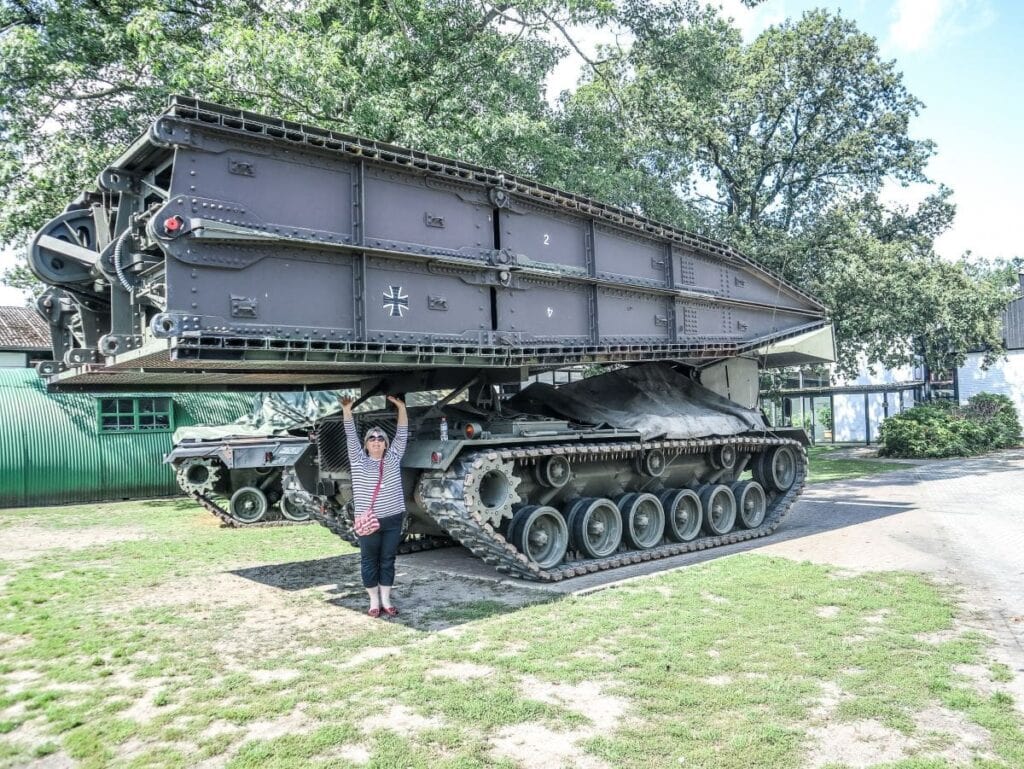
Top tip: If you do not speak fluent German, ask for one of the English language audio guides when purchasing your ticket, as much of the exhibit signage is in German.
The exhibits follow a logical, chronological order, and it is fascinating to see how these mighty but fearful machines became the leviathan beasts they are today. Look out for the Sturmpanzerwagen A7V from WWI, the Panzer tanks and the collection of armoured machinery from the Cold War years.
Outside, there is a massive Brückenlegepanzer M48 – a bridge-laying vehicle – and a Leopard 1 tank that you can climb up and sit inside! Contributed by Coralie of the Grey Globetrotters.
Rothenburg ob der Tauber
Rothenburg ob der Tauber is considered one of the most picturesque towns in Germany. The storybook village along Germany’s Romantic Road is known for its medieval appeal, with cobblestone streets and half-timbered buildings capped with red roofs. The town is a popular tourist destination in Germany, welcoming more than 2.5 million visitors each year.
Museum lovers will enjoy the Medieval Crime and Justice Museum and the small but interesting Christmas Museum. In winter, the small town also hosts one of the most enchanting Christmas markets in Germany in its central Market Square or Marktplatz.
While there are museums, cathedrals, and even a tower you can climb, one of the best things to do in Rothenburg ob der Tauber is to simply wander the mesmerizing streets. The most popular photo spot in Rothenburg can be found just before you get to the south gates of the walled town. Plönlein is a yellow building with a small fountain in front of it, nestled between the forked streets of Kobolzeller Steige and Untere Schmiedgasse.
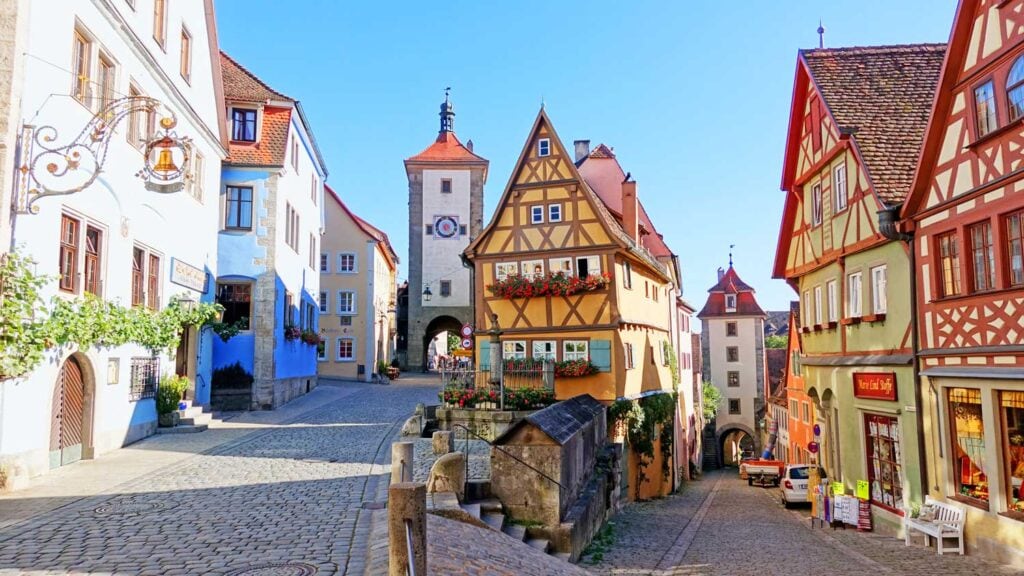
After admiring the pretty street, make your way to the town walls. Walking along the top of the former defensive walls gives you great views of both the town and the Tauber Valley.
If you enjoy guided tours, be sure to take the Night Watchman’s Tour. The Night Watchman, adorned in medieval attire, walks you through the town while recounting historic tales and even humorous stories that are appropriate and entertaining for all ages. Contributed by Melissa from Parenthood and Passports.
Neuschwanstein castle
You can’t go to Germany and not see Neuschwanstein Castle the inspiration for Disney’s Cinderella Castle. Schloss Neuschwanstein is an incredibly elaborate castle near Füssen built atop a rock ledge over the Pöllat Gorge in the Bavarian Alps. The Mad King Ludwig ordered the castle built in 1868 but was never completed.
Louis II (the Mad King) wanted to build a medieval castle inspired by Hohenschwangau Schloss and hoped to have the castle built in 3 years however much of the castle wasn’t finished until 1892 and only around a dozen rooms were complete.
Louis died by drowning himself in 1886 and several weeks after he died the castle was opened to the public as a museum, these days the Castle receives around 1.3 million visitors a week.
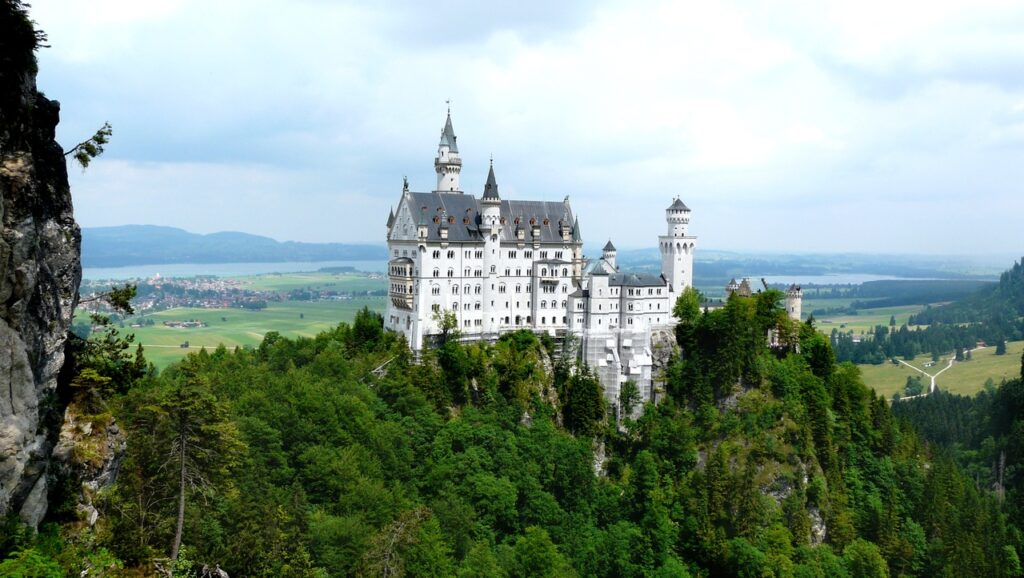
Within the castle’s two-story throne room which is modelled after a Byzantine Basilica, you can admire the blue vaulted ceiling with gold stars supported by red porphyry columns. Louis was a patron of Richard Wagner, and wall paintings throughout the castle depict the legends that inspired the composer: the life of Parsifal in the fourth-floor Singers’ Hall; the Tannhäuser saga in the study; and Lohengrin in the great parlour.
Lichtenstein Castle
The Liechtenstein Castle, situated on the southern edge of the Vienna Woods, is the family seat of the Prince of Liechtenstein. The Romanesque castle dates from the year 1130 but the present castle was built in the 19th Century by the restored house of Liechtenstein and is still located on their property.
Often hailed as the “fairy-tale castle of Württemberg”, Lichtenstein Castle is a romantic castle built by Count Wilhelm of Württemberg to pay homage to medieval times.
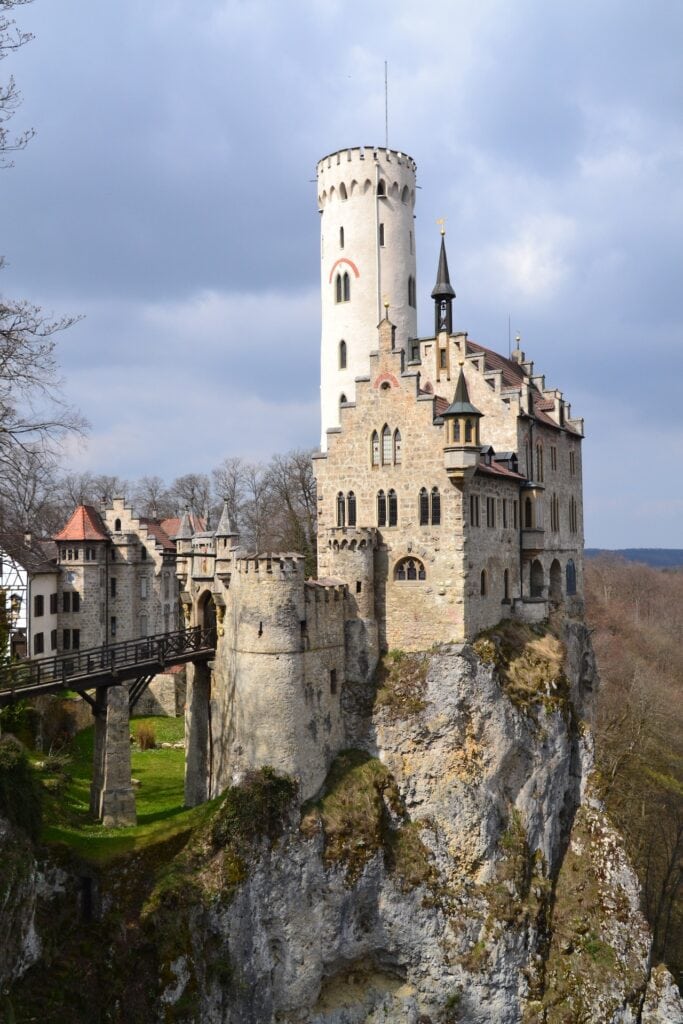
The structure we see today was largely inspired by the novel Lichtenstein by Wilhelm Hauff. The castle has an impressive location: perched on an 800 meters-high cliff just on the edge of the Swabian Alps, it offers magnificent views of the surrounding landscape and the valley of the Echaz river, a small tributary of the Neckar river.
The name Lichtenstein translates as “shining stone”.
Schloss Hohenschwangau
Hohenschwangau castle is located in Southern Germany across from the world-famous Neuschwanstein castle. The castle is in the town of Schwangau, which is near the city of Füssen and on the border with Austria.
Schloss Hohenschwangau was first built in the 12th century. However, the castle was abandoned in the 16th century and in ruins by the time Crown Prince Maximilian of Bavaria stumbled upon them on a walk. He bought the ruins and let the castle be rebuilt in neo-gothic romantic style in 5 years. It’s till the present day a yellow-coloured castle with 4 corner turrets.
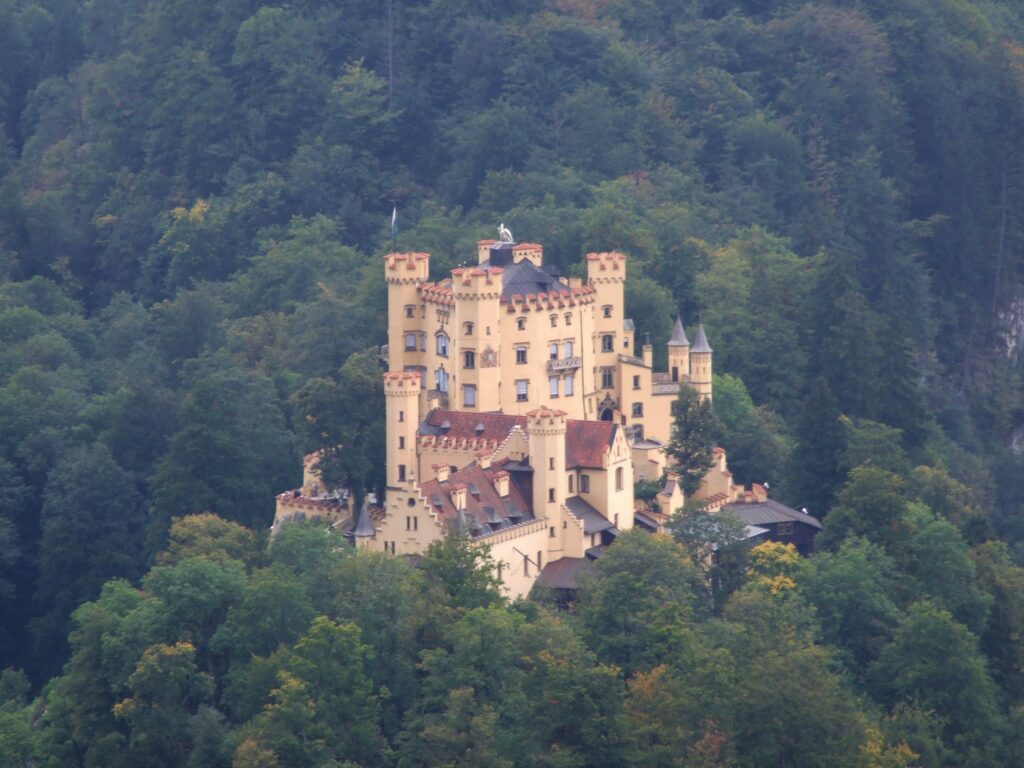
Giving it a distinct fairytale and medieval appearance. The symbol of the swan is omnipresent. The interior of the castle is done in Biedermeier style. There are over 90 wall paintings, mostly with German mythology as the theme.
The castle can only be visited on a 45-minute guided tour. Tickets can be pre-booked online or bought at the ticket centre in town, not at the castle itself. Tickets cost €21.00 for adults and €18.00 for kids 7 and up. The castle is open year-round, although opening times vary.
There’s no elevator in the castle, however, there are 90 steps in total in the castle. Animals are not allowed inside the castle. Cars can’t be parked at the castle, but need to be parked in the town of Schwangau. The best option is parking lot P4. From this parking lot, it’s a 20-minute uphill hike to the castle. There are also carriages going from the parking lot to the entrance of the castle, these cost extra. Contributed by Cosette from KarsTravels.
Bastei Bridge
Perhaps one of the most stunning attractions on a perfect Germany bucket list is the Bastei Bridge in Saxon Switzerland, a true natural gem in the south near Dresden. Outdoor enthusiasts, nature lovers and photographers especially love this picturesque region: countless hiking trails lead through breathtakingly beautiful landscapes, through deep gorges, green fairy-tale forests and up to the local Elbe Mountains’ magnificent viewpoint.
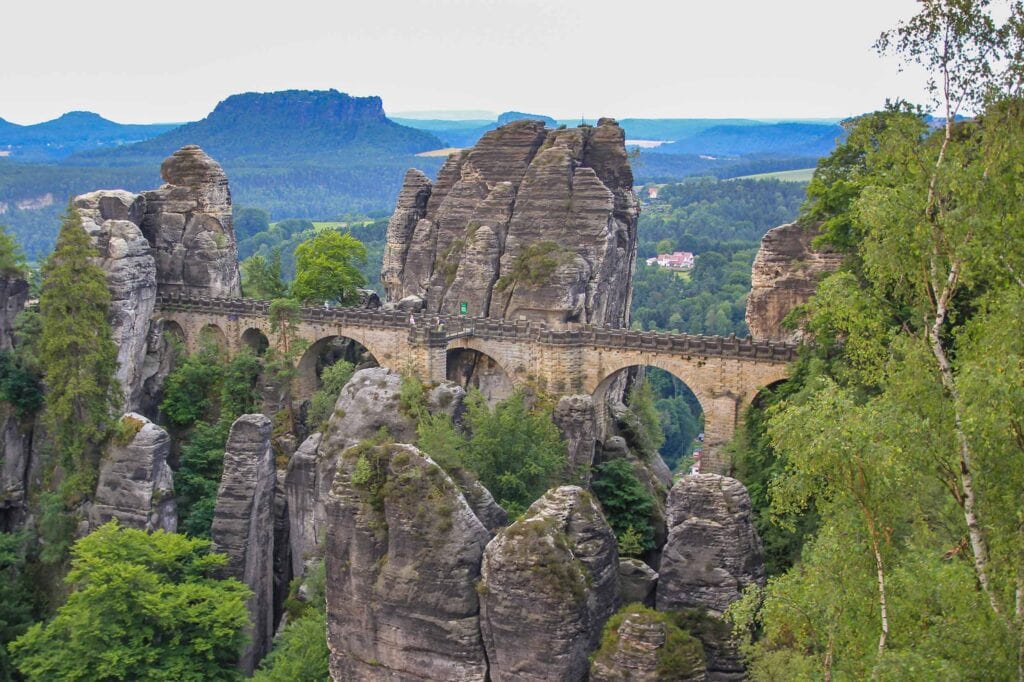
An absolute highlight for many travellers is a visit to the world-famous Bastei Bridge. This outstanding landmark is a stone bridge that connects very extraordinary rock formations. The scenery is so unique and special that approximately 1.5 million tourists from all over the world come to experience this impressive attraction every year. From the Bastei Bridge, the rock descends steeply to the Elbe River 194 meters above. From there you can enjoy fantastic views of the Elbe Valley and the rock needles of the mountains.
It’s definitely worth spending a few days in the area. Besides the famous Bastei Bridge, there are many other great things to see! A visit to the Königstein fortress or a bike ride along the beautiful Elbe is fun, and you can hike along the famous Malerweg. Nostalgic steamboat tours are pleasurable, and the Schandauer Therme is worth a visit too. The easiest way to get to Bastei Bridge is to drive or rent a car. The nearest international airport is in Dresden, about 45 km away. Contributed by Martina of PlacesofJuma.
Berlin
It feels obligatory to visit Berlin just because it’s the capital of Germany, but this fascinating city is also much more than that. There are so many things to do in Berlin which is bursting with rich history, creative street art, breathtaking architecture, scrumptious culinary scene, and epic nightlife, there really is a lot for one to discover.

History aficionados would thrive here. Museum Island alone has five museums, with lots of great gems scattered around the city, like the Wall Memorial Museum. The nation’s past as a Soviet State may be harrowing, but it can be important to learn about this deep history. From the Jewish Museum, The Holocaust Memorial to the Topography of Terror, these are just some places to stop by.
The local food is also reason enough to visit Berlin. Their most famous dish, currywurst, is served in street stalls and restaurants alike, and you can find delicious doner kebabs throughout the city. In December, the numerous Christmas markets are a brilliant place for a food-tasting experience like no other.

And of course, not to mention their reputation for producing world-class beer. While all of Germany are known to make excellent beers, Berliners are at the forefront of this craft. Their city is known as the beer capital of the world for a reason. From beer gardens and pubs to unique craft beer spots, you could spend days just exploring the beer landscape here.
The best thing about Berlin is that while it offers you a quick overview of the country’s culture, history, and cuisine, it’s also a perfect gateway to different remarkable destinations. Renting a campervan lets you explore places like the important Sachsenhausen Concentration Camp or peaceful Spreewald, just a few hour’s drive away! Contributed by Bradley of Dream Big Travel Far.
Nuremberg
Nuremberg is an absolute must-visit on your Germany Bucket List because it’s a place of important history, holds urban culture, has some of the prettiest streets in Germany and has the best German Christmas markets.
Nuremberg, known as Nurnberg in German, is located in Northern Bavaria in Germany and has its own international airport and train station that can be reached from other places in Germany as well as bordering countries like Austria and Czechia.
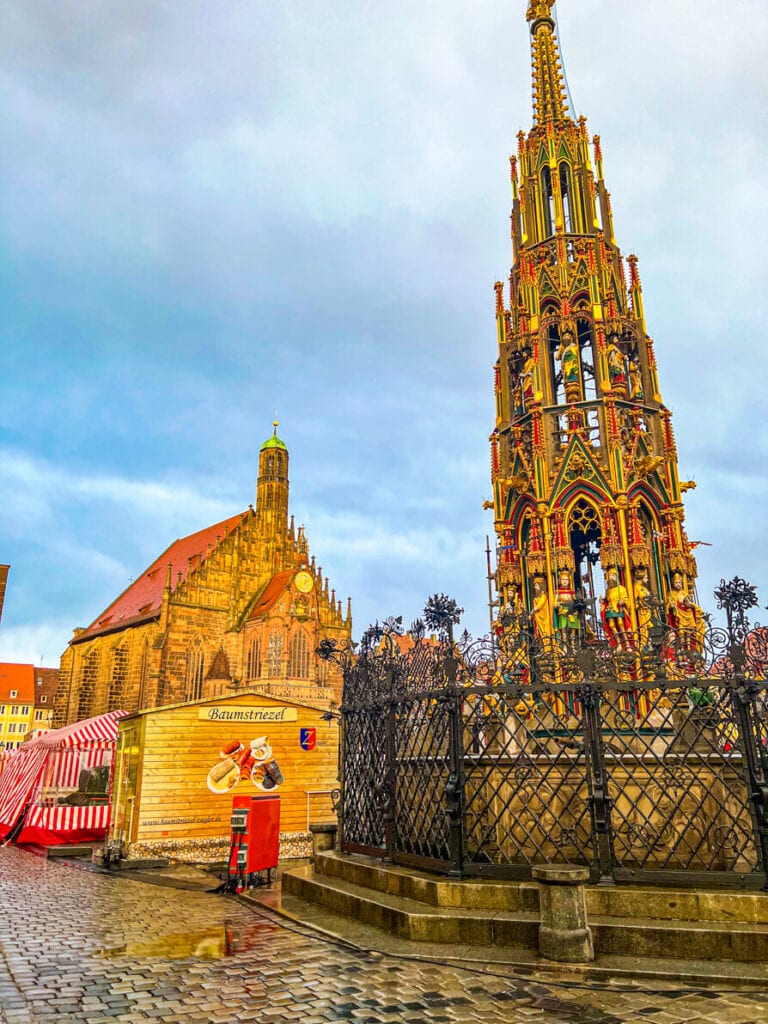
There are lots of things to do here whether you spend just a day in Nuremberg or a whole weekend including trying Lebkuchen, the most famous gingerbread snack from the region, exploring the outdoor markets (especially if visiting at Christmas time), finding the golden statue on the main Platz which is said to be lucky if you turn the gold ring, and visiting the prettiest German places seen in postcards and Instagram grids, both the Hangman’s Bridge and Weissgerbergasse Street are the best spots to visit. Don’t miss the popular street food in Nuremberg called which consists of three small bratwursts in bread served with mustard (and washed down with a German beer).
Nuremberg was also the place where the Nuremberg Trials were held to bring leading Nazis to justice with international judges. Today you can visit the Memorium Nuremberg Trials where they have a permanent exhibition giving all information about the trials, defendants, outcomes and atrocities. Courtroom 600 is also available in the same place which is the actual room where the trials took place. Submitted by Shireen from The Happy Days Travels.
Cologne Cathedral
Cologne Cathedral is Germany’s greatest Gothic cathedral and one of Europe’s most popular tourist attractions. In acknowledgement of its outstanding architecture, it was added to UNESCO’s World Heritage list in 1996.
It was over 600 years in the making. Although work began in the mid-13th Century, Cologne Cathedral wasn’t completed until 1880 with the erection of its iconic twin towers.
This is a church that defies superlatives. Kölner Dom is not only one of the largest cathedrals in the world in terms of floor space (just south of 800 square meters), but it is also the highest twin-spired church in the world and the second-tallest cathedral in Europe (Lincoln Cathedral in England beats it to the top spot).
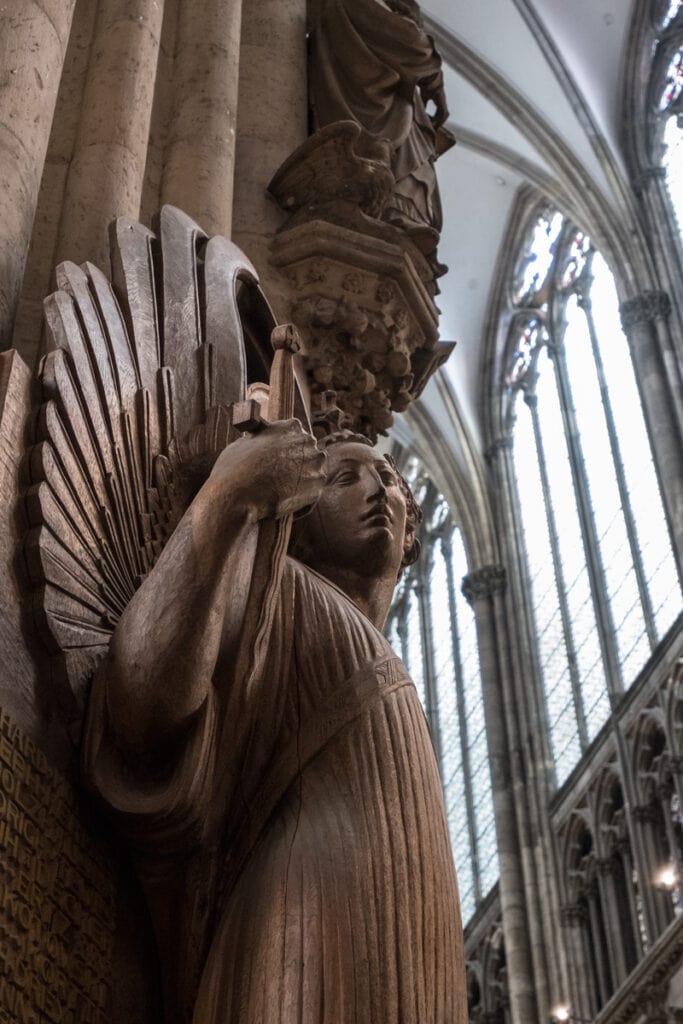
Cologne has been a major pilgrimage site for centuries. The cathedral is said to be the final resting place of the Three Wise Men. Their bones were brought to Cologne from the conquered City of Milan in the 12th Century and are held at the Shrine of the Three Magi, a lavishly gilded reliquary hat is decorated with jewels and enamel.
Looking for a miracle? Ascribed with miraculous powers, the Madonna of Milan, a painted wooden sculpture, has also been drawing pilgrims since Medieval times.
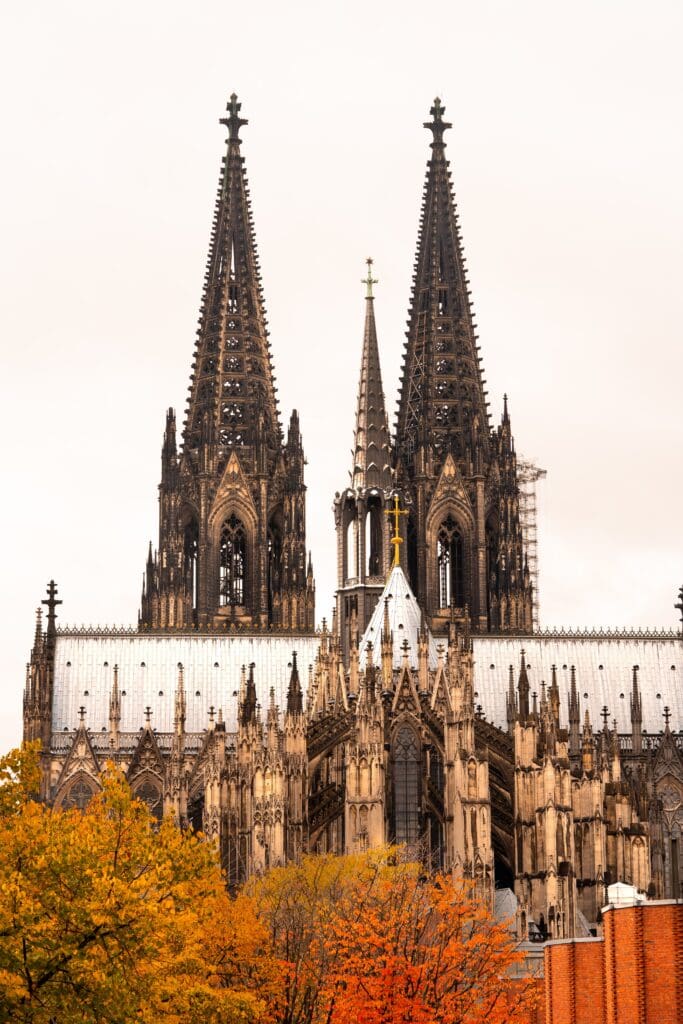
Cologne Cathedral is also home to the sublime Gero-Crucifix. Carved in the 970s, this is the oldest surviving monumental crucifix north of the Alps.
It is free to visit Cologne Cathedral. If you want to climb the 533 steps to the summit of the cathedral’s South Tower or visit the Cathedral’s Treasury, small fees apply. Contributed by Bridget from The Flashpacker.
Hamburg
Hamburg is one of the best cities in Germany, with a fantastic young vibe and plenty of things to do and see. Located in the North of the country, Hamburg is the second largest city in Germany – you can easily reach Hamburg from Berlin in less than two hours by train.
Hamburg is both traditional and modern. One of the best-preserved areas in the city is the old warehouse district, where at the beginning of the 20th-century ships would come from all over the world with spices, coffee and other exotic goods. Now, this area is home to modern coffee shops, museums, and apartments.
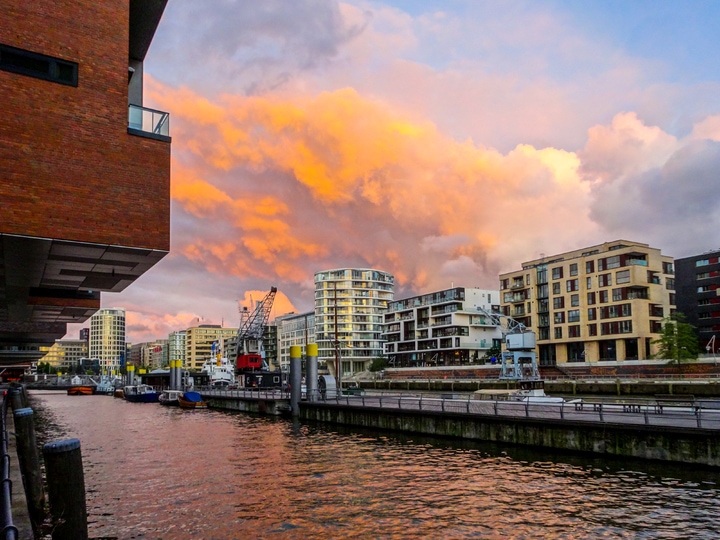
One of the greatest museums to visit here is the Miniatur Wunderland, the largest model railway in the world. They even have an airport where planes are “landing” and “taking off”. The time of the day is also simulated inside the giant halls, so a visit here is a must.
Another great thing to do in the city is indulge in the great local food. There are so many amazing places to eat in Hamburg serving traditional, as well as fusion food.
Hamburg is a very green city, with plenty of parks, as well as a beautiful waterfront.
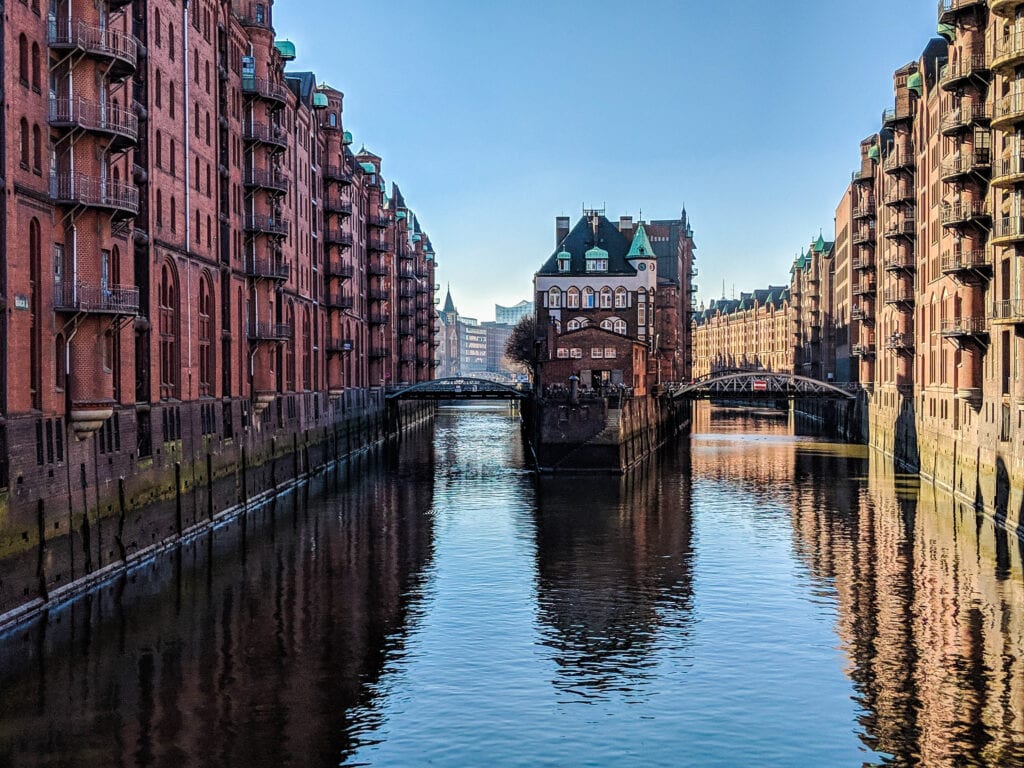
For a unique experience, book a ticket to a concert at the Elbphilharmonie. This is Hamburg’s opera house, which can also be visited. The viewing platform is free of charge – and you can get an incredible view over the entire harbour from up there. Contributed by Joanna of World in my Pocket.
Bacharach
Bacharach is a wonderful town situated on the stretch of the Upper Middle Rhine River. Knowns as one of the most preserved towns in Germany, Bacharach has numerous lively villages on the river. The town has also been listed as UNESCO World Heritage Site and the beauty of the town justifies this a lot. With quiet and calm rivers and vineyards on the hillsides, there’s a lot to the town that makes this place worth visiting.
The town is located at a distance of just 50 km from Koblenz and about 87km from Frankfurt. You will find Bacharach on the left bank of the stunning Rhine Gorge. It is one of the best Rhine towns you’ll visit and there are a lot of things to explain this.
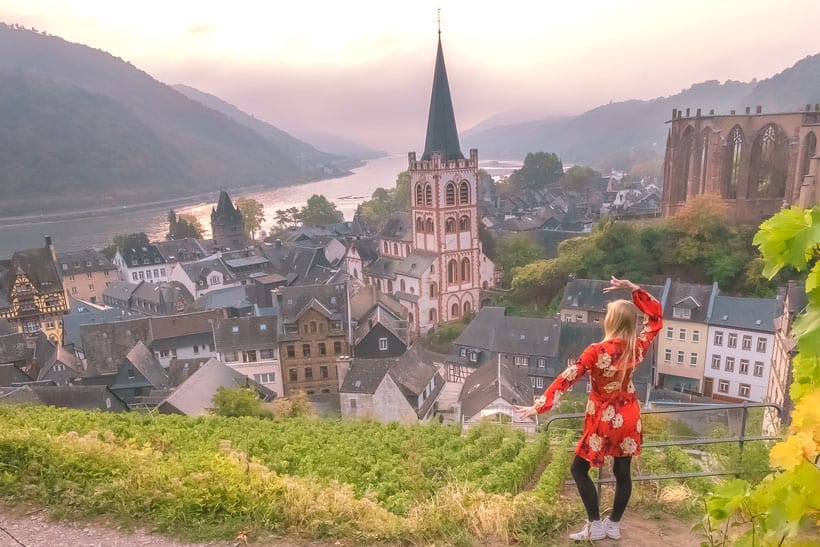
Start your excursion by taking a picture at Marktturm, which is the official entrance to the town. It cuts through the old city wall and is very pleasing to the eye. It also has a lot of history to it so do not miss out on capturing it.
Continue with the most famous cruise down the Rhine. It can be a great start to one of the most beautiful river cruises you will get in Europe. As you move further, you will see rolling vineyards, hilltop castles lined up, and storybook towns.
Conclude your day with a visit to Burg Stahleck, which was originally built in the 12th century. Then satisfy your hunger at Altes Haus, which also has a history of its own. Contributed by Paulina of Paulina on the Road.
Die Rhon
Die Rhön (The Rhön) is a hilly area in central Germany located in the German states of Bavaria, Hesse, and Thuringia. Die Rhön is primarily a nature destination but there are beautiful little towns scattered
throughout.
In 1991, Die Rhön was listed as a UNESCO Biosphere Reserve. This part of Germany is known for its hiking and paragliding in the summer months and skiing and snowshoeing during the cold and snowy wintry months.
Some of the more popular destinations in Die Rhön include Kreuzberg and Wasserkuppe. Kreuzberg is located near the town of Wildflecken. There is a monastery at Kreuzberg that has some of the best beer in all of Germany. The monastery has been active since the late 1600s by Franciscans and to this day they still brew their famous Kloster Bier (monastery beer).
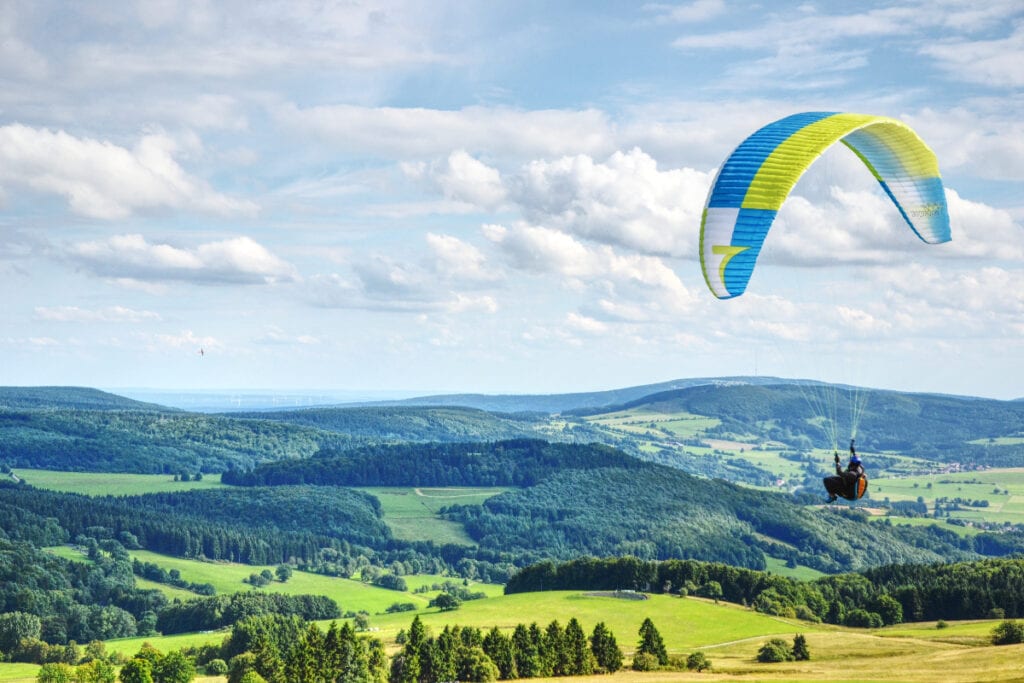
People travel from around the world to hike around Kreuzberg and end the exhausting day with a cold Kloster Bier and a hearty meal. Another popular destination in Die Rhön is Wasserkuppe. Wasserkuppe is Die Rhön’s tallest mountain. When first arriving, visitors will notice the gliders and paragliders buzzing around the sky. Because of the altitude, vast meadows, and rolling hills, the Wasserkuppe is ideal for beginners learning to fly the gliders or take a shot at paragliding.
There are many activities for all ages at Wasserkuppe including Rodelbahn (alpine sledding), hiking, and mountain biking. There are playgrounds here for children and lovely places to sit down and enjoy a coffee and cake.
Die Rhön not only has beautiful nature worth exploring but some of the towns are worth visiting as well.
It is recommended to pay a visit to both Bad Brückenau and Bad Kissingen. Both towns have charming downtown areas and are home to many great restaurants and cafes. For those that love spending time in nature and enjoy hiking, Die Rhön is one of Germany’s best-kept secrets and is well worth visiting. Contributed by Brandon from Zimmin Around the World.
Bayreuth, Germany
One awesome destination you need to add to your Germany bucket list is Bayreuth. This Bavarian town is well known for its cultural music venues and is home to the UNESCO World Heritage Site, the Margravial Bayreuth Opera House and the home to famous German composer Richard Wagner who has a museum and hosts his annual festival at the Bayreuther Festspielhaus.
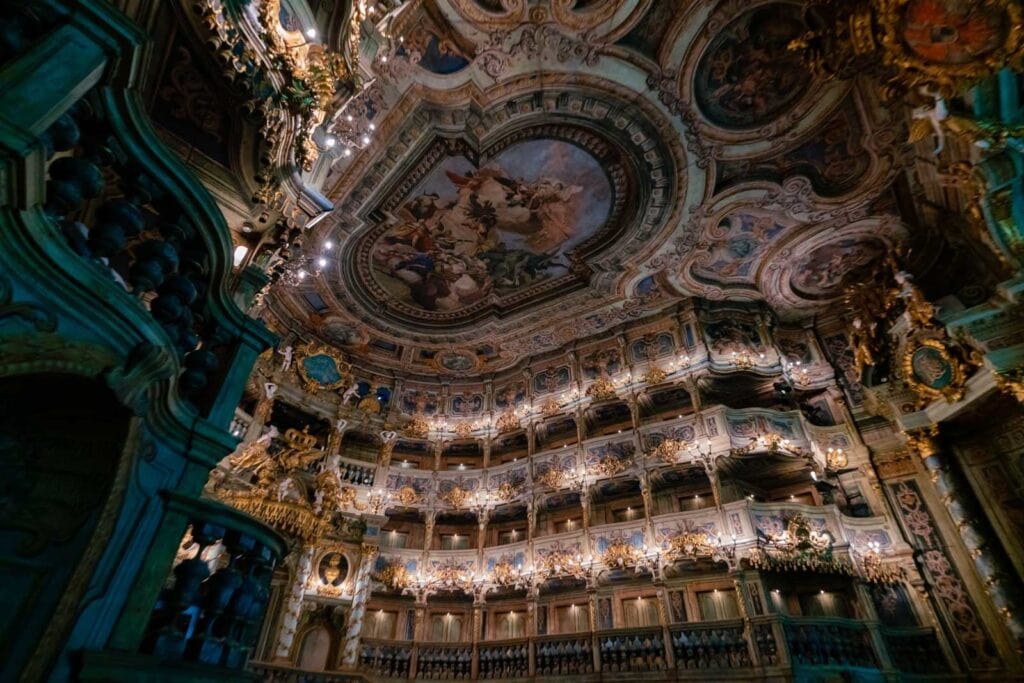
Beyond being culturally rich in the music and opera scene, you can find other great sites in Bayreuth to check out like the stunning Hermitage Gardens which is a great place to take a stroll and admire the Rococo architecture.
If you’re a fan of architecture you can find more beautiful 18th-century homes on Friedrich Street, aka Bayreuth’s millionaire’s row. Since much of Bayreuth was bombed and destroyed in WWII, it’s impressive to see what architecture survived and still stands here.
And for beer lovers, you’ll also want to enjoy a tour and tasting at Maisel’s Bier-Erlebnis-Welt. Contributed by Megan of Bobo and Chichi.
Potsdam
If you’re planning a trip to Germany, Potsdam is a destination you shouldn’t miss, especially if you’re visiting Berlin. It’s loaded with history and beauty, and it’s easy to reach. A small city located southwest of Berlin, you can easily take a day trip to Potsdam from Berlin and see much of what is on offer.
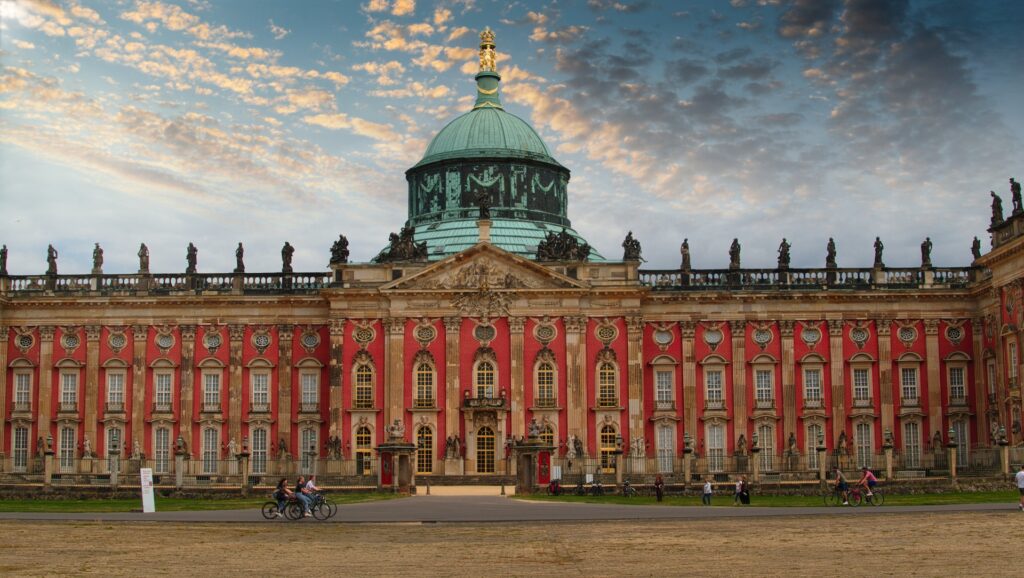
Potsdam is mostly known for its collection of gorgeous palaces and gardens, which make up the majority of the UNESCO site called Palaces and Parks of Potsdam and Berlin. These palaces were summer homes and retreats for former Prussian (German) royalty, and they were built anywhere from the late 1600s to the early 1900s.
The most well-known palace in Potsdam is Sanssouci. It was the summer palace for Frederick the Great, who was king of Prussia in the mid-1700s. People often compare Sanssouci to Versailles in France, but it is a smaller palace. Together with the ornate gardens and fountains, Sanssouci is a gorgeous place to explore.
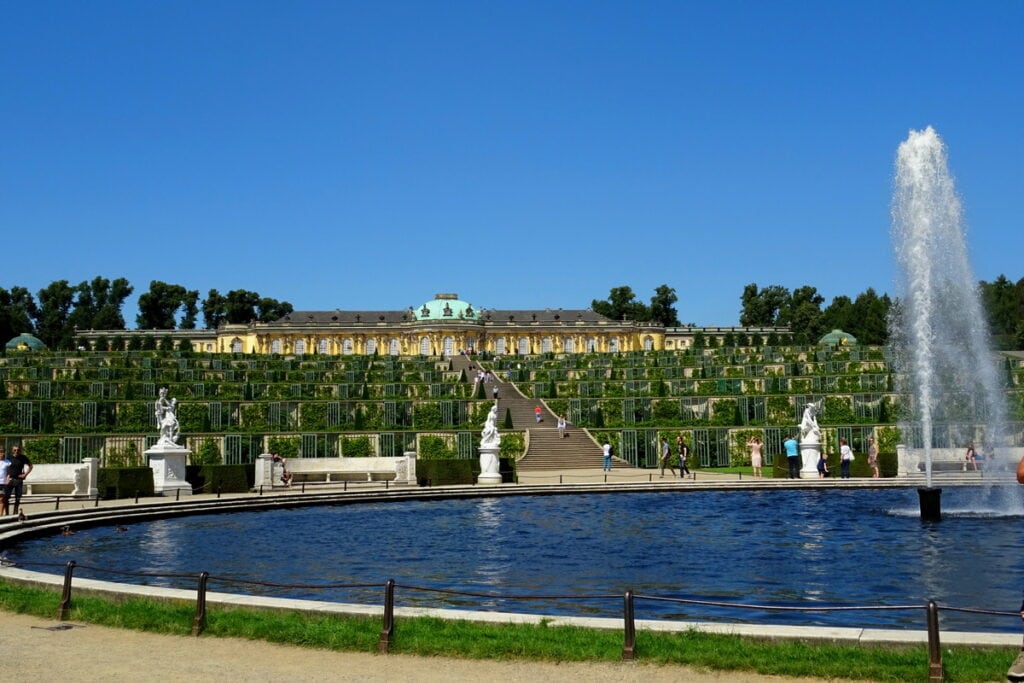
On your visit to Potsdam, you should also see the New Palace. It was also built for Frederick the Great, but it is more elaborate than Sanssouci. Cecilienhof Palace is a good one to visit for its more recent history. The Potsdam Conference was held here, which marked the end of World War II and the beginning of the Cold War.
There are plenty of other palaces to visit in Potsdam, including the Marble Palace, Babelsberg Palace, Charlottenhof Palace, Orangery Palace, and more. And don’t forget to check out the town itself where you’ll find three old city gates, the Dutch quarter, a few churches, and a few museums.
To get to Potsdam Hbf, take the regional train RE1, which takes about 25 minutes from Berlin Hbf, or take the Sbahn line S7, which takes about 35 minutes from Berlin Hbf. Contributed Ali from Berlin Travel Tips.
Eibsee
Eibsee or Lake Eibsee is one of the most beautiful lakes in Germany that is located in the South German state of Bayern (called Bavaria in English). The lake is about 100 km south of Munich and only a 1.5-hour drive away. Furthermore, there are multiple options to reach Eibsee by public transportation. You must first take a train to Garmisch-Partenkirchen from the Munich main train station and then another train to Grainau, the closest station to Eibsee. From Grainau, you can reach Eibsee after a scenic and easy hike of 4.5 km.
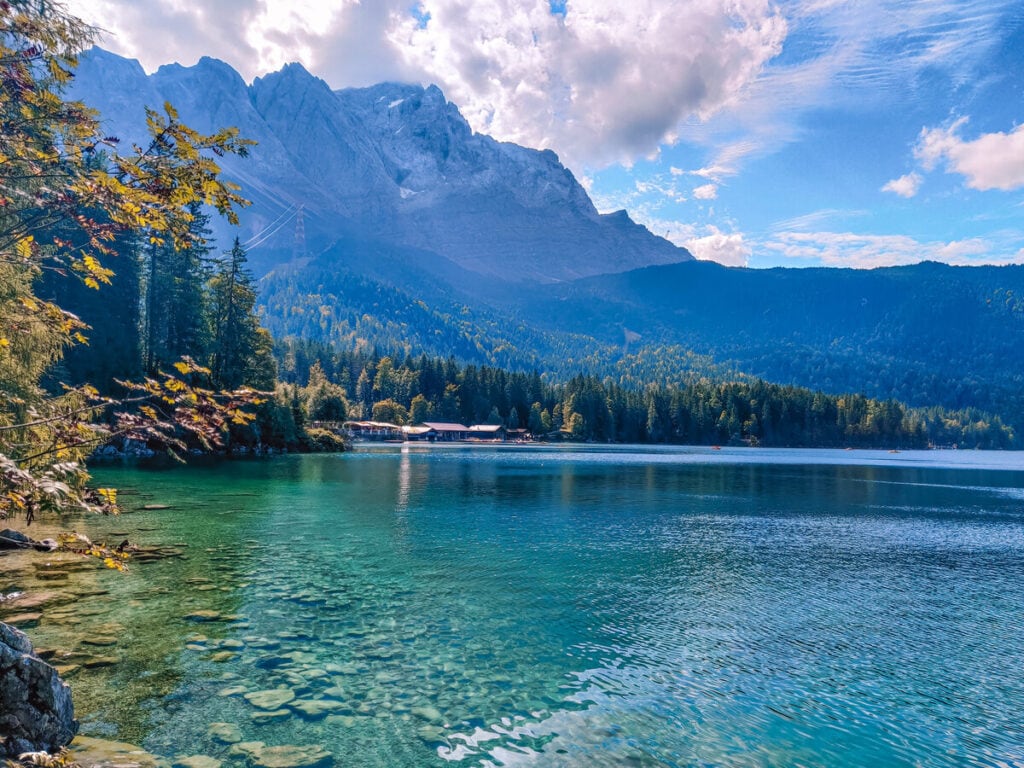
There is a large parking lot, a hotel, a coffee shop and a restaurant at Eibsee. The lake has a shore length of approximately 8 km and a walking trail all around it. And so, one of the best things to do at Eibsee is to walk the trail along the lake. Additionally, one can even hire paddle boats at the boat station near the entrance to the lake. If you happen to stay at the Eibsee hotel then you can directly rent boats from the hotel itself. During summer, most people bring their own canoe or kayak to the lake and swimming in the clear waters is also one of the highlights of visiting Eibsee in summer.
The clear turquoise waters of Eibsee coupled with a view of the Bavarian Alps and Zugspitze – the highest point in Germany make this lake an unmissable place to visit in Germany. Contributed by Soujanya of the Spicy Journey.
Garmisch
Garmisch, located in the heart of Bavaria in the Southeastern part of Germany, is a beautiful fairy tale town surrounded by Alpine mountain ranges, castles, and emerald lakes. Due to its enchanting natural landscapes, this place is visited by tourists from all over the world. It is also a perfect day trip from Munich, and there are many things to do in Garmisch for all interests and ages.
Garmisch is also a ski resort town famous for skiing, ice skating, hiking, and snowboarding. So adventure lovers and winter sports lovers love to visit Garmisch.
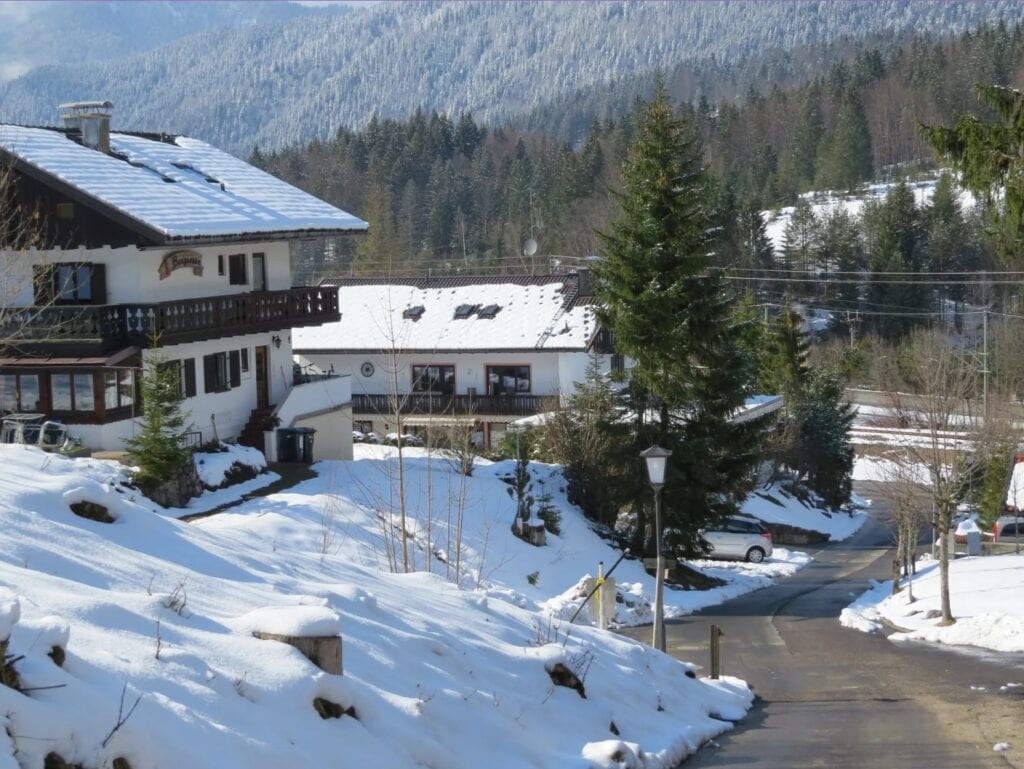
Garmisch hosted 1936’s winter OLYMPICS GAMES, so you can find top-notch winter sports facilities here.
Zugspitze Mountain is also situated here, and with a height of 2962 m above sea level, it is the highest point in Germany. You can reach the mountain’s top by hiking or cable cars. Cable cars are the easiest access method to the top of Zugspitze peak.
The Upper Palatinate Forest near Garmisch has more than 4700 lakes; therefore, this region is famous for its beautiful emerald lakes. Lake Constance, Eibsee, and Starnberg are this region’s most famous and scenic lakes. This Garmisch is a favourite amongst nature lovers too.
The most famous Neuschwanstein Castle is just 27 km away from Garmisch, making it a perfect spot to visit for history and culture lovers.
Garmisch must visit Munich town during your Germany visit due to many beautiful tourist attractions with nature activities and tours. Contributed by Yukti Agrawal, from Travelwithme24x7.
Düsseldorf
Düsseldorf is the seventh largest city in Germany and is located in the western part of the country on the river bans of the Rhine River. Unfortunately, most of the historic city centre was destroyed in World War II, which is why you won’t see a lot of historic structures and landmarks.
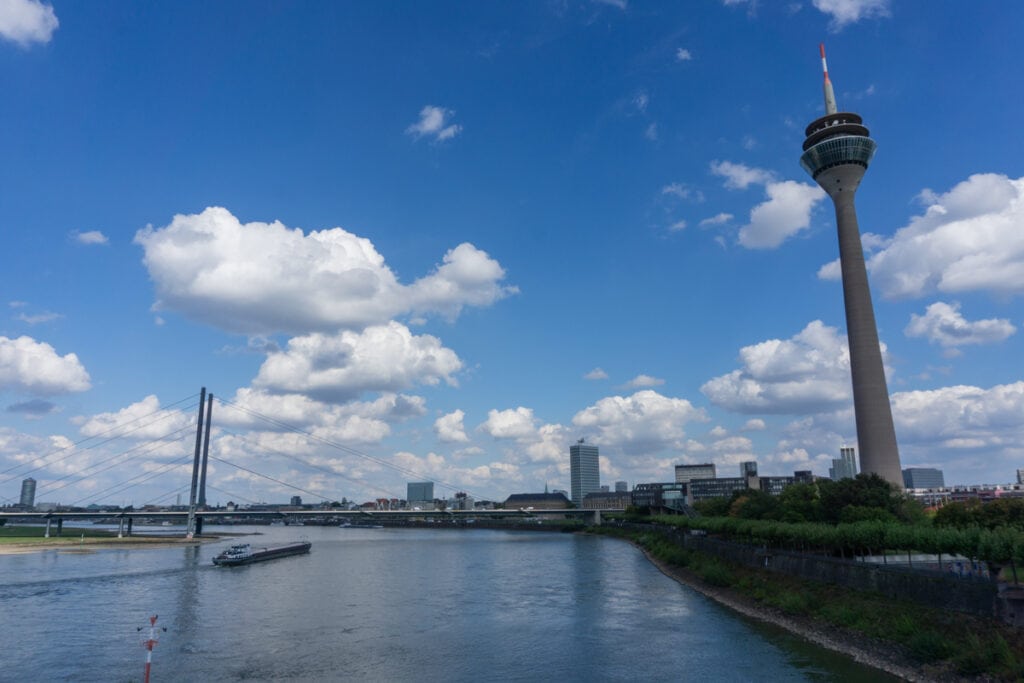
However, it’s now a very modern city, with really interesting architecture, art museums and a lot of great bars and restaurants. There are many fun things to do in Düsseldorf. Since art is so important, you’ll be able to spot a lot of colourful street art, especially around the Academy of Arts. You can find some of the most interesting buildings at the Neuer Zollhof, these are designed by the famous architect Frank Gehry.
And did you know that Düsseldorf is home to the longest bar in the world? In Aldstadt (the historic city centre), you’ll find no less than 300 bars and nightclubs. A great place to grab a drink or for a fun night out.
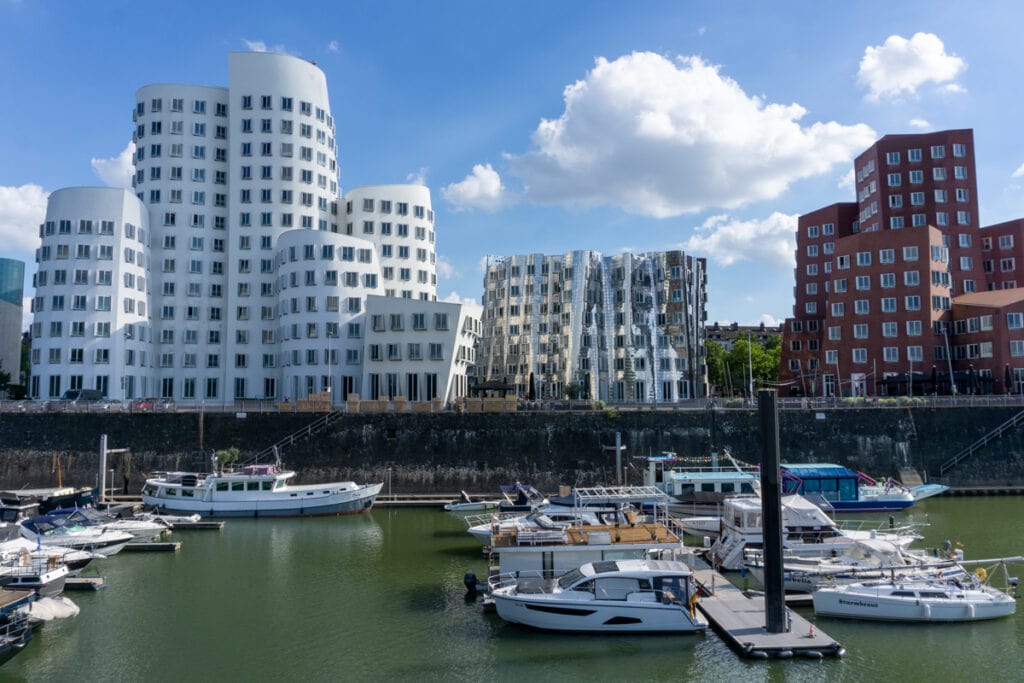
In Winter, Düsseldorf is the place to be if you want to visit a Christmas Market. From November 17th till December 23rd there’s this big Christmas Festival where you can drink mulled wine and watch craftsmen create art.
Are you looking for the best view of Düsseldorf? Make your way to the Rheintur, a 240.5-meter high tower. On clear days, you can see really far, and you might even see the city of Cologne. As you can see, Düsseldorf is a fantastic place to spend a weekend! Contributed by Jacoba of Opreismetco.
Tubingen
Located about a 45-minute drive away from Stuttgart in southern Germany is the beautiful town of Tubingen. The small town is known for being home to one of the oldest universities in Europe and an abundance of university students, creating a student-town atmosphere.
While the town is on the smaller side, it’s a great place to visit even if you can only spend one day in Tubingen! In terms of activities to do, the city has plenty to fill your itinerary.
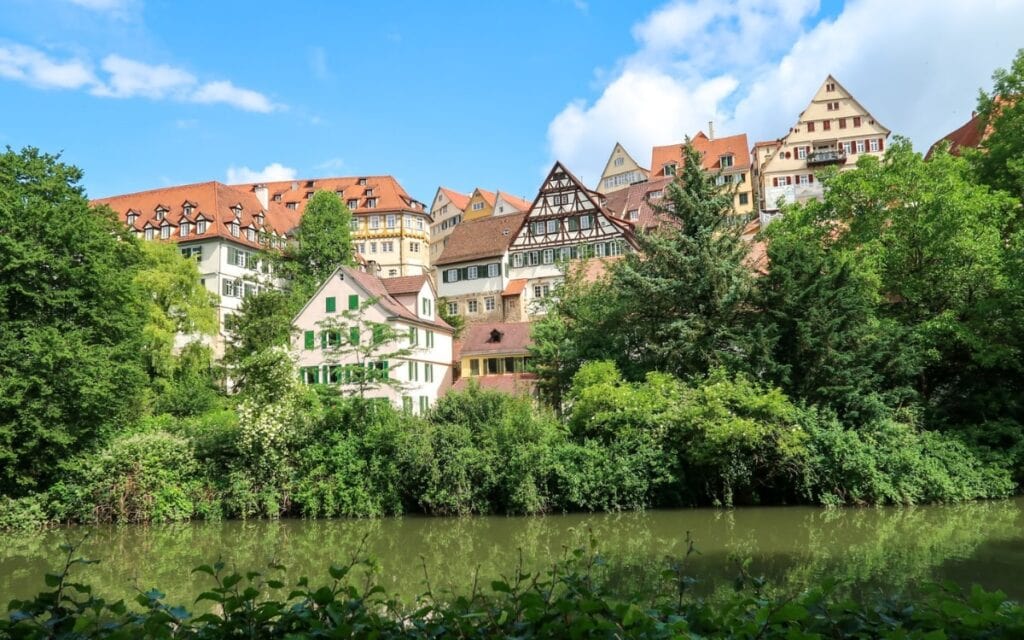
For example, any history and architecture lovers should be sure to tour Tubingen University. The university was established in 1477 and features lots of old-world architecture and even has a few small museums tucked within. Today, the university is highly recognized for its theology and religious studies programs.
Meanwhile, for those looking to do some shopping, the market square is the perfect place to find handcrafted souvenirs or gifts for loved ones back home. If you get there early in the morning, you’ll even be able to catch the local farmers’ market.
Lastly, for visitors who just want to sit back and relax, head to the Neckar waterfront. The Neckar River runs through the middle of Tubingen and provides gorgeous views of the cityscape. There is also a park near the waterfront that is great for leisurely strolls.
Whether you’re interested in history, shopping, or just want to relax, Tubingen has something for everyone. Thus, if you’re looking for a new place to visit in Germany, be sure to consider Tubingen! Contributed by Kristin Lee of Global Travel Escapades
Frankfurt
Frankfurt, officially called Frankfurt am Main, is best known as the European Financial hub. As you admire the skyscraper skyline, it is not hard to see why they call it the German Big Apple.
While Frankfurt is one of the biggest German cities, it is not as popular a tourist destination as other large cities like Berlin and Munich. In fact, most people visiting Frankfurt are there for business. However, that makes it one of the most underrated destinations in Germany!
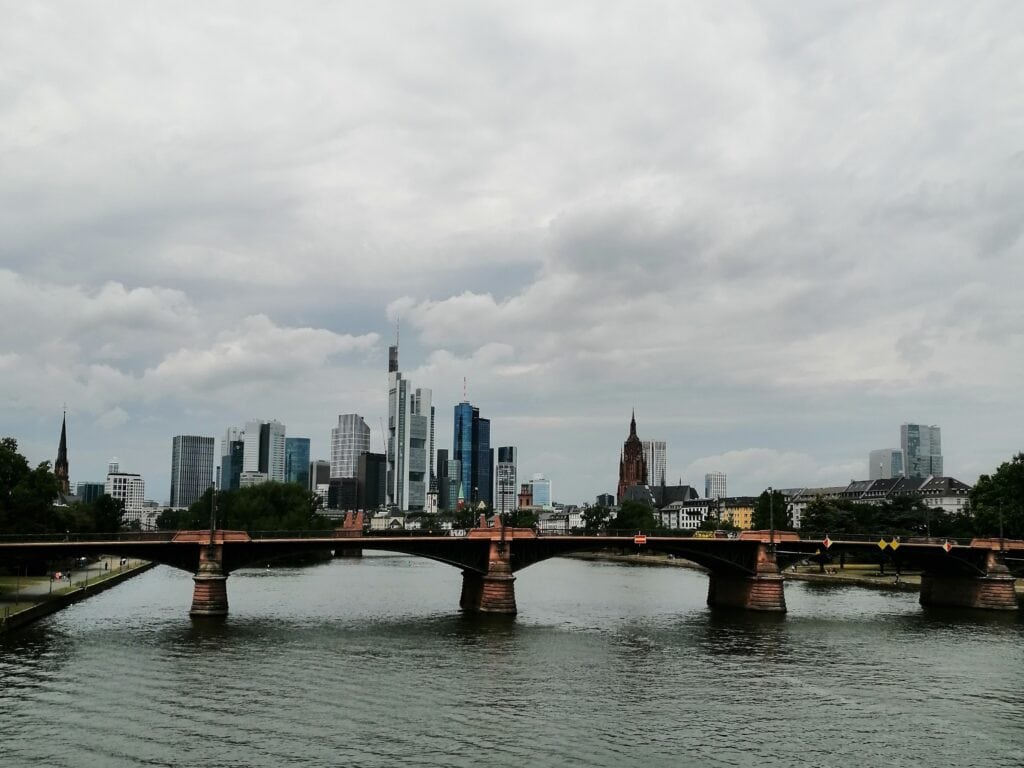
Frankfurt is a city with two radically different aesthetics, the old town with colourful houses and cobblestone streets and the business neighbourhoods with glass facade skyscrapers. The pedestrian Iron Bridge is the best place to observe this blend of the old and the new and a must-visit on your trip to Frankfurt.
Discover the charming Römerberg quarter, entirely rebuilt in traditional style after destruction in WWII. For the best view of the city, climb the viewing platform of the majestic Frankfurt Imperial Cathedral.
Taste Frankfurt’s speciality – Apfelwein in a laid-back neighbourhood of Sachsenhausen, just across the river from Römerberg.
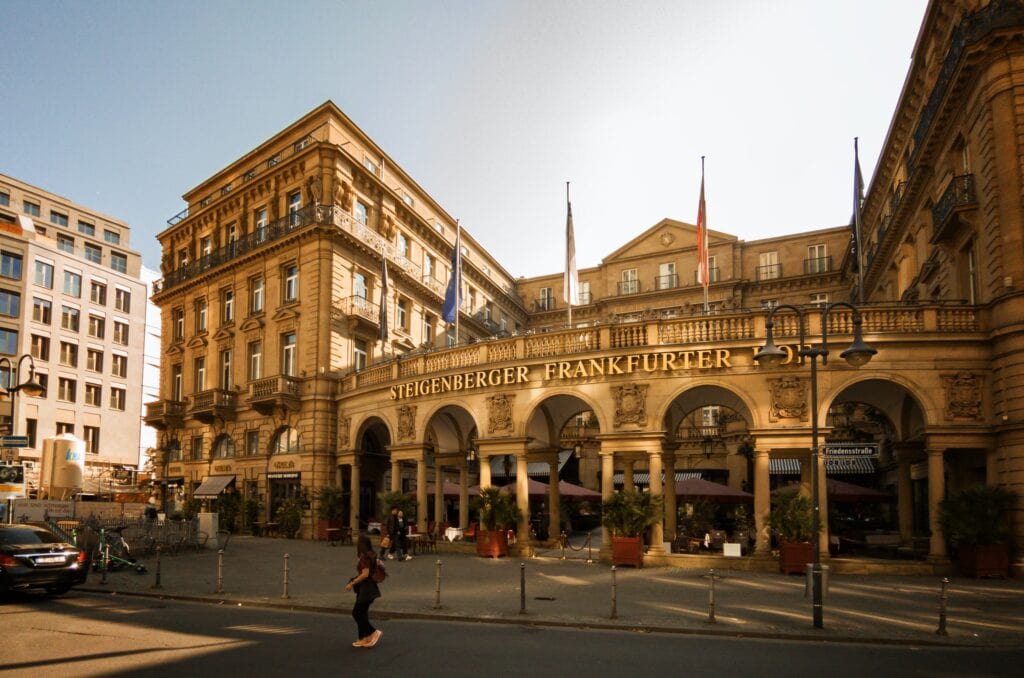
Frankfurt is delightful any time of the year, yet it is the best to visit in the summer. As the days get longer and warmer, you get to experience the lively atmosphere of the city, enjoy strolling by the river and discover Frankfurt’s city forest. Yes, Frankfurt has a forest, perfect for a day in nature, almost within walking distance of the city centre.
Frankfurt is a great base to explore this region of Germany. Take a day trip to Rothenburg, the most photogenic town in the whole of Germany, discover the romantic city of Heidelberg, or spend a day in Strasbourg, discovering the french Alsace region. Contributed by Natali – from She’s abroad again.
Oberammergau
Oberammergau is a quaint, picturesque town in the Bavarian Alps, most well known for its once-a-decade Passion Play (also referred to as the Passionsspiele). The play, which depicts the trial and crucifixion of Jesus Christ, began performances back in 1634. The local folktales say that the town made a deal with God: save them from the bubonic plague sweeping across Europe, and they’d perform the Play every decade. And so the performance continues to this day!
All 2000 actors, singers, instrumentalists, and technicians are residents of Oberammergau, and they put their whole hearts into every aspect of the show. Even if you’re not involved in Christianity, the performance is absolutely astounding and a must-see for anyone in the region. Shows typically take place between mid-May and early October in years ending in zero- with special performances for the play’s anniversaries and no shows in 2020 due to Covid.
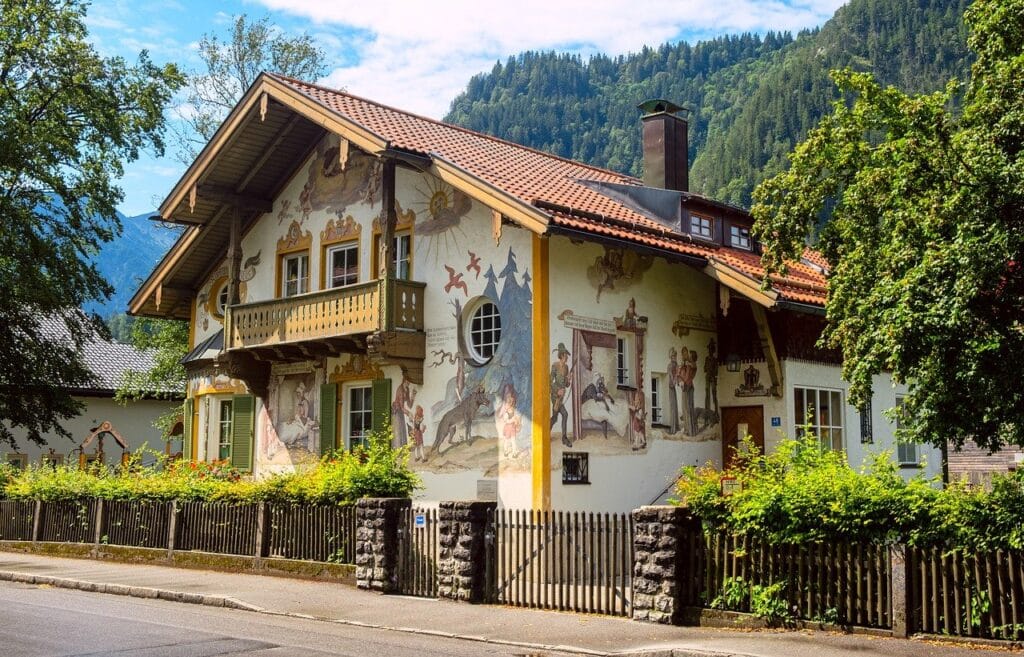
If you can’t be in town for the Passion Play, you can still thoroughly enjoy Oberammergau. Shops, homes, and other buildings often sport Lüftlmalerei decorations, which are essentially murals in a traditional German style that give the entire area a boost of charm. The local Oberammergau Museum features incredible wood carvings by local artisans, plus gorgeous Renaissance-style traditional art.
Whether you’re coming for the arts, culture, or Passion Play, your best bet is to take a bus or train to Oberammergau. The winding roads of the Bavarian Alps can be difficult to navigate for those unfamiliar with the area– especially if you’re leaving after the Passion Play, which is well after the sun sets. If you decide to rent a car, there is plenty of parking available in the town, and most attractions are easily walkable.
This Germany travel guide was a collaborative article written by travel bloggers from around the world. These are their favourite places to visit in Germany.
What’s your favourite German place to visit?
You might also like
34 Tantalizing German foods – what to eat in Germany
UNESCO Intangible Cultural Heritage – food
Pin it for later
